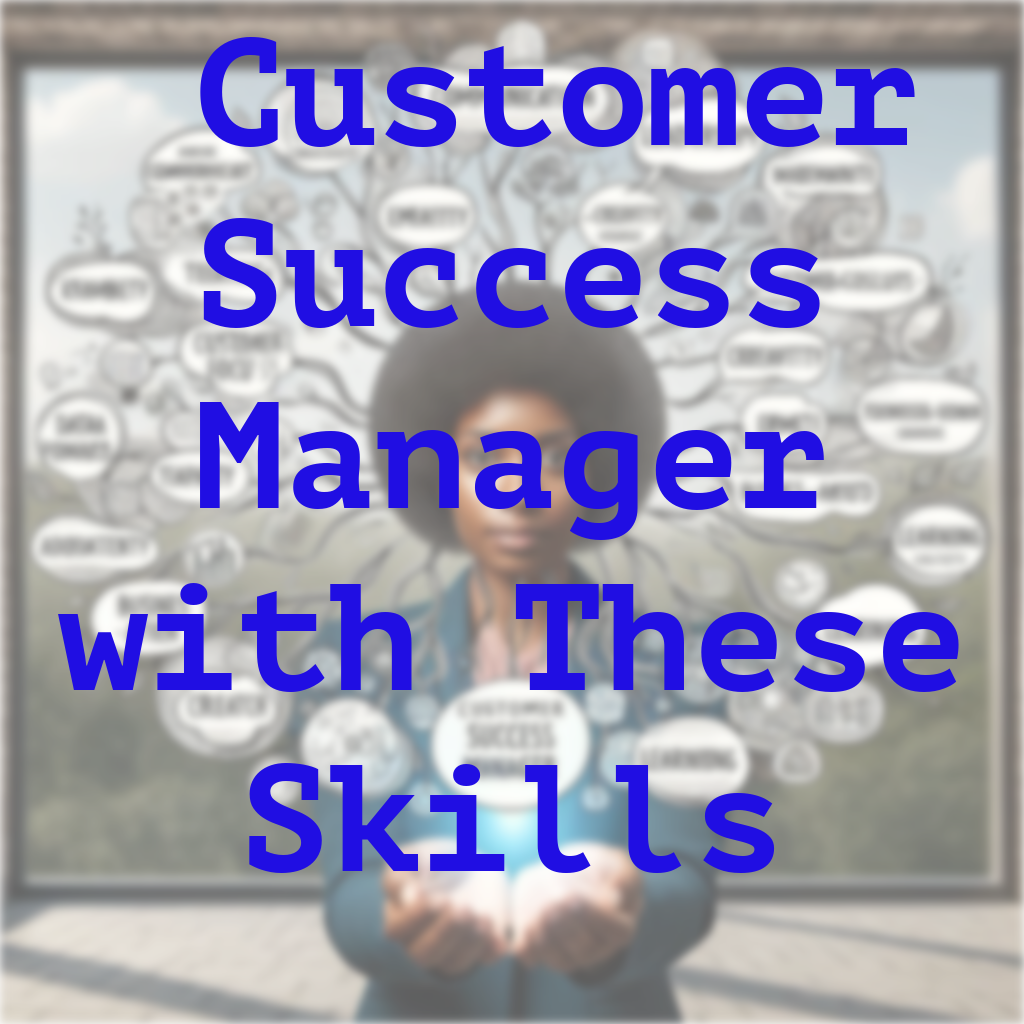Introduction:
If you are a Customer Success Manager, you know how important your job is for your company and your customers. You are not just a service provider but also saddled with the responsibility of a trusted advisor, a problem-solver, and a relationship-builder. There is always a need to master a variety of skills to be the best and to fit into various that are constantly changing and evolving.
In this article, I’ll show you what those skills are and how to develop them in different domains.
1. Communication Skills:

As a Customer Success Manager, you know that communication is the most important skill for your job. You have to communicate with different kinds of customers, from tech-savvy to business-oriented. You also have to communicate with your own team and other departments.
Communication is not only about talking or writing but also about listening and understanding to respond accordingly. You have to listen to your customers’ problems, goals, and feedback, and empathize with their situation.
You also have to adjust your communication style to fit the audience, the situation, and the purpose. Whether you are solving problems, giving updates, or providing insights, you have to use communication as a way to create and maintain positive relationships.
How to Improve Your Communication Skills as a CSM for Different Scenarios
– Technical communication: When you communicate technical information, such as product features, functionality, or troubleshooting, you have to be accurate and simple. You have to use the right terms and avoid jargon or acronyms that might confuse the customer.
You also have to give clear instructions, examples, and screenshots to show your points. You can improve your technical communication skills by keeping up with the latest product updates, reading technical documentation, and asking for feedback from your colleagues or managers.
– Business communication: When you communicate business information, such as value plan, ROI, or strategy, you have to emphasize the benefits and results for the customer. You have to use data and evidence to back up your suggestions and recommendations. You also have to use persuasive and professional language to influence the customer’s choices.
You can improve your business communication skills by researching the customer’s industry, objectives, and challenges, preparing well for meetings and presentations, and following up with brief and clear summaries and action items.
– Interpersonal communication: When you communicate on a personal level, such as building a relationship, showing appreciation, or dealing with objections, you have to demonstrate empathy and respect for the customer. You have to use active listening techniques, such as rephrasing, asking open-ended questions, and recognizing emotions. You also have to use positive and practical feedback, compliments, and recognition to motivate and keep the customer. You can improve your interpersonal communication skills by practising emotional intelligence, self-awareness, and mindfulness, seeking feedback from your customers and coworkers, and reflecting on your own strengths and areas for improvement.
2. Sharpen Problem-Solving and Critical Thinking:

You need to apply critical thinking to solve complex problems and deliver value to your customers. The ability to think quickly and creatively to handle different scenarios, find the root causes, and propose effective solutions. You also need to think ahead and proactively to avoid potential problems and ensure smoother customer outcomes.
Some critical thinking skills as a CSM for different challenges
– Product-related challenges: These are challenges related to bugs, errors, or feature requests that affect the product functionality or performance. To deal with them, you need to use your product knowledge and technical skills to diagnose and resolve them. You need to ask the right questions, test hypotheses, and use data and evidence to support your conclusions. You also need to communicate clearly and concisely with your customers, your product team, and your support team. You can boost your product-related critical thinking skills by keeping up with the product roadmap, reviewing product documentation, and asking for feedback from your product and support colleagues.
– Customer-related challenges: These are challenges related to churn, dissatisfaction, or complaints that affect customer satisfaction or loyalty. To address them, you need to use your customer knowledge and interpersonal skills to understand and empathize with the customer’s perspective, needs, and goals.
You also need to provide constructive and positive feedback, recommendations, and solutions that match the customer’s expectations and interests. You can enhance your customer-related critical thinking skills by researching the customer’s industry, segment, and persona, preparing well for customer interactions, and asking for feedback from your customers and managers.
– Strategy-related challenges: These are challenges related to retention, expansion, or advocacy that affect the customer’s lifetime value or growth. To tackle them, you need to use your business knowledge and analytical skills to plan and execute them.
You need to identify opportunities, risks, and trade-offs, and use data and metrics to measure and evaluate your performance. You also need to use persuasive and professional language to influence and convince your customers, your team, and your stakeholders. You can improve your strategy-related critical thinking skills by researching the market, the competition, and the best practices, setting SMART goals and action plans, and asking for feedback from your team and stakeholders.
3. Technical Proficiency:
Customers expect more than a general overview of your company’s offerings. They want CSMs who can handle the technical aspects of your software, solve problems efficiently, and show them how to use your features perfectly. Technical skills are crucial for CSMs to deliver high-quality support and build trust with customers.
How can you improve your technical skills in different domains?
– Learn about the latest and most important innovations and changes in your field. Consume blogs, newsletters, podcasts, and webinars that cover topics related to your software and your customers’ needs. This will help you acquire new concepts, terminology, and best practices that you can apply to your work.
– Use your software frequently. Explore its functionalities, test its performance, and experiment with different scenarios. This will help you become familiar and confident with your software and spot potential issues or areas for improvement.
– Ask for advice and support from your colleagues and mentors. Ask questions, share insights, and learn from their experiences. You can also join online communities, forums, or groups where you can interact with other CSMs and experts in your domain. This will help you grow your network, gain new perspectives, and find new resources or solutions.
– Enroll in online courses, certifications, or workshops that can boost your technical skills. There are many options available for different levels, budgets, and schedules. You can choose the ones that match your goals, interests, and learning style. This will help you gain new knowledge, skills, and credentials that can enhance your credibility and career prospects.
4. Customer Empathy:
Customer empathy can help you build trust and loyalty with your customers. They will appreciate your genuine interest and care for their success. They will also be more likely to recommend you to others and stay with you for the long term.
Develop and improve customer empathy in different domains by doing these:
– Listen actively. Don’t just hear what the customer is saying, but listen to how they are saying it. Ask open-ended questions to clarify and explore their situation. Resist the urge to interrupt, judge, or making conclusions
– Reflect and validate. Repeat what the customer has said and check if you understood them correctly. Express empathy and acknowledge their feelings. For example, “It sounds like you are frustrated with the current system. I can understand how that must feel.”
– Show curiosity and interest. Learn more about the customer’s background, context, and preferences. Ask them about their goals, challenges, and expectations. Try to find out what motivates them and what matters to them.
– Offer solutions and support. Based on your understanding of the customer’s situation, propose solutions that address their needs and goals. Explain how your product or service can help them overcome their challenges and achieve their desired outcomes. Provide guidance and assistance throughout the customer journey.
– Follow up and follow through. Keep in touch with the customer and monitor their progress and satisfaction. Solicit feedback and suggestions for improvement. Deliver on your promises and exceed their expectations. Celebrate their success and thank them for their trust.
5. Data Analysis and Reporting
As a customer success manager, you want to help your clients get the most out of your product or service. how do you know what they need, what they like, and what they struggle with? The answer is data analysis.
Data analysis allows you to understand your customers’ behavior, satisfaction, and outcomes, and use that information to provide them with personalized guidance and support.
To master data analysis as a CSM, you should focus on three key areas:
– Data collection: You should be able to find and access the data that matters for your clients. This can include qualitative data, such as feedback from surveys, interviews, or reviews, and quantitative data, such as metrics from usage logs, analytics platforms, or CRM systems. You should also be able to formulate the right questions to guide your data collection.
– Data analysis: You should be able to use the appropriate tools and techniques to make sense of the data you collect. This can include using spreadsheets, dashboards, charts, or graphs to sort and display data, and applying statistical methods, machine learning, or natural language processing to uncover insights and patterns.
– Data communication: You should be able to share and explain the data you analyze in a way that is clear and relevant for your audience. This can include using reports, presentations, or stories to communicate data, and emphasizing the main findings, implications, and suggestions for improvement.
6. Customer Onboarding Expertise:
Onboarding is more than just a one-time event. It’s the beginning of your customer’s journey with your product or service. It’s where you make your first impression, and where you can win or lose their trust and loyalty.
As a CSM, you have to master the art of onboarding, guiding your customers from the moment they sign up to the moment they start using your solution. This means creating captivating and informative onboarding materials, providing effective and customized training sessions, and solving any problems or questions promptly and professionally. You can ensure a smooth and seamless transition for your customers and lay the foundation for a lasting and fruitful relationship when you do this.
How can you improve your onboarding skills in different domains?
– Research your customers’ needs and expectations. Before you plan your onboarding strategy, you need to know who your customers are, what they hope to accomplish with your product or service, and what obstacles they face. This will help you adapt your onboarding content and approach to their specific goals and pain points, and give them the most relevant and valuable information.
– Use a variety of onboarding methods and formats. Depending on your product or service, your customers may have different preferences for learning and interacting with you. Some may like to watch a video tutorial, some may like to read a user guide, some may like to join a live webinar, and some may like to chat with you directly.
You should provide a range of onboarding options and formats, and let your customers pick the ones that suit them best. This will boost their engagement and retention, and accommodate their different learning styles and preferences.
– Measure and optimize your onboarding performance. To make sure that your onboarding process is working well, you need to track and analyze your onboarding metrics and feedback.
Some of the key indicators to watch are customer satisfaction, activation rate, churn rate, time to value, and feature adoption. You should also gather and review your customers’ feedback, both positive and negative, and use it to spot the strengths and weaknesses of your onboarding process.
Based on your results, you should constantly test and improve your onboarding materials, methods, and outcomes, and aim for excellence.
7. Cross-Functional Collaboration:
As a CSM, you are the link between your customers and your company. You have to collaborate effectively with different teams, such as sales, marketing, and product development, to make sure that your customers are happy and loyal. This means having strong collaborative skills, which are crucial for sharing customer insights and expectations with your colleagues.
By establishing trust and understanding with your internal partners, you can adopt a more organised and customer-focused culture in your organization.
Here are some tips for different domains on how to develop and improve your collaborative skills as a CSM.
– Sales: Work closely with the sales team to align your goals and strategies, and exchange relevant customer data and feedback. Assist the sales team in finding and pursuing upselling and cross-selling opportunities, and smoothly transition new customers to your portfolio.
– Marketing: Work with the marketing team on customer advocacy programs, such as testimonials, case studies, and referrals. Give the marketing team customer stories and success metrics, and work together on creating targeted campaigns and content.
– Product Development: Work with the product team to convey customer needs and pain points, and push for product enhancements and features that benefit your customers. Join product testing and feedback sessions, and keep your customers informed on product changes and roadmaps.
8. Time Management and Prioritization:
Being a Customer Success Manager means handling multiple tasks and customer demands at once. You have to be smart about how you use your time and decide what matters most, without letting your service quality or customer happiness suffer. This skill is essential for your own efficiency and success, as well as for building long-term relationships with your customers.
How can you master this skill in different situations?
– Set Specific, Measurable, Achievable, Relevant, and Time-bound goals. By setting SMART goals, you can define what you want to accomplish, how you will track your progress, and when you will finish your tasks. This will help you concentrate on the most important and realistic results, and avoid spending time on unimportant or impossible ones.
– Use a prioritization matrix: A prioritization matrix is a tool that helps you sort your tasks based on their urgency and importance. You can use a simple 2×2 matrix, where you place each task in one of four categories: urgent and important, urgent but not important, important but not urgent, and neither urgent nor important. This will help you determine which tasks you should do first, which ones you can assign or outsource, and which ones you can delay or delete.
– Create a daily schedule: A daily schedule is a plan that shows how you will allocate your time during the day. You can use a calendar, a planner, or an app to make your schedule, and include your tasks, meetings, breaks, and other activities. This will help you manage your time efficiently, and avoid interruptions or distractions. You should also check your schedule at the end of the day, and assess how well you followed it, and what you can improve for the next day.
– Practice the Pomodoro technique: The Pomodoro technique is a time management method that involves working in short, focused sessions, followed by short breaks. You can use a timer, or an app, to split your work into 25-minute segments, called Pomodoros, and take a 5-minute break after each one. You can reward yourself with a longer break of 15 to 30 minutes after doing four Pomodoros. This will help you keep your focus, motivation, and energy levels, and avoid exhaustion or fatigue.”



